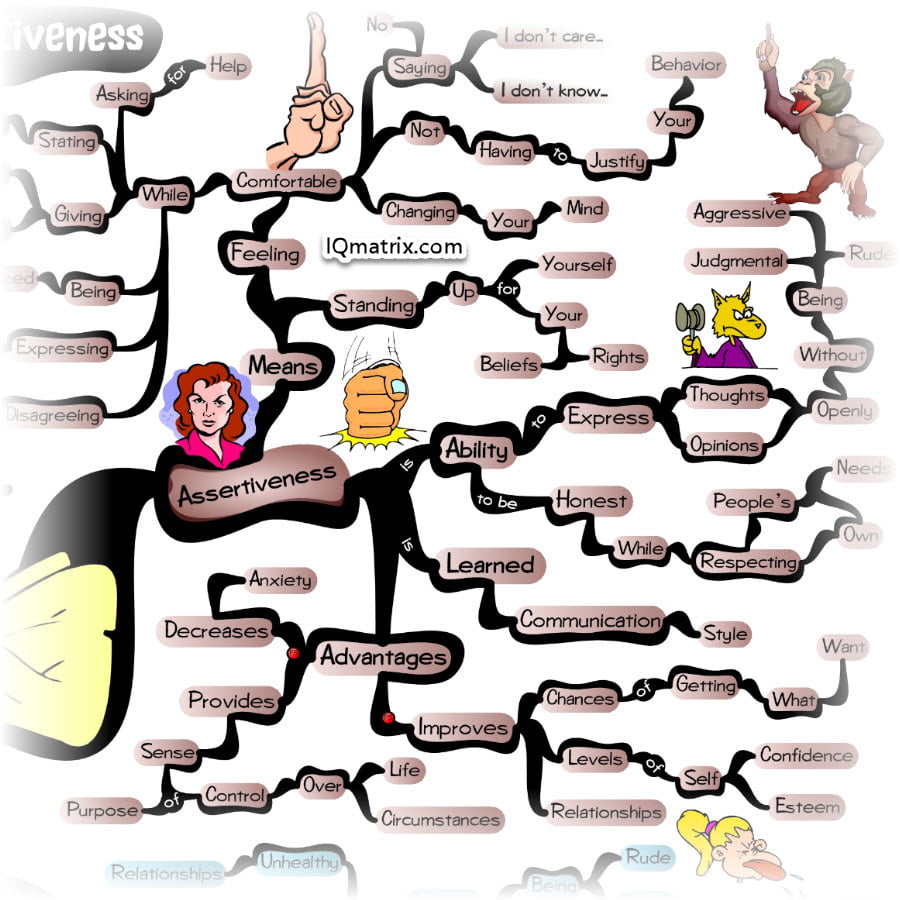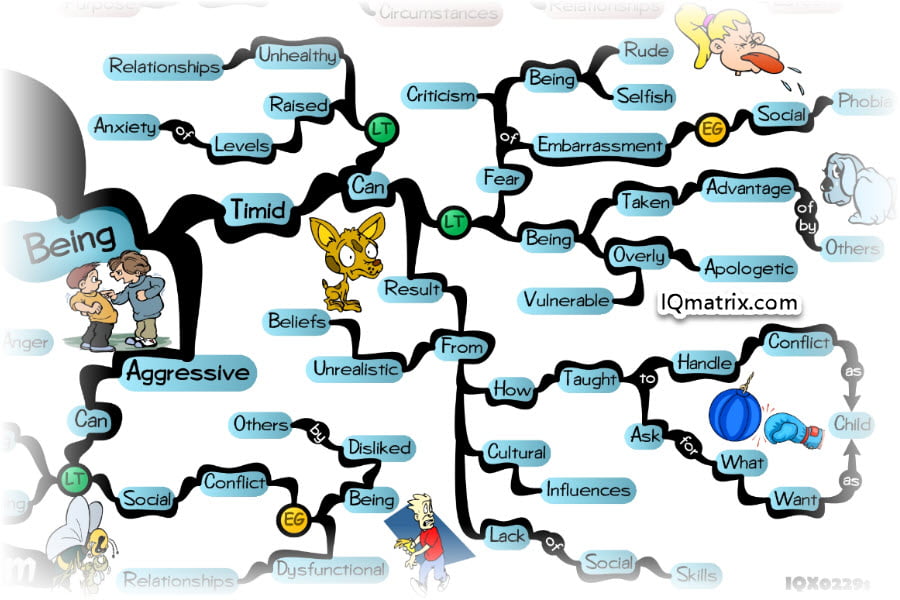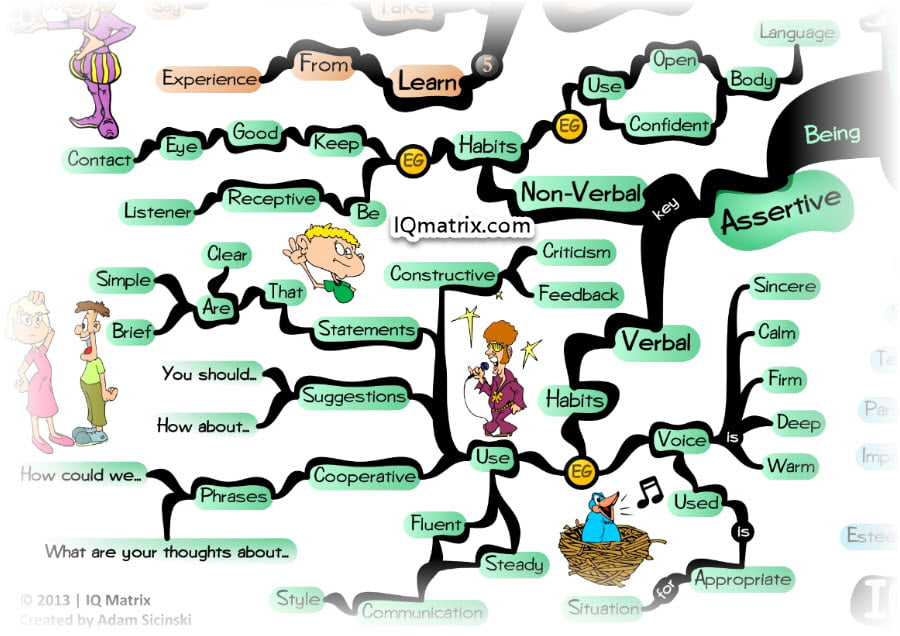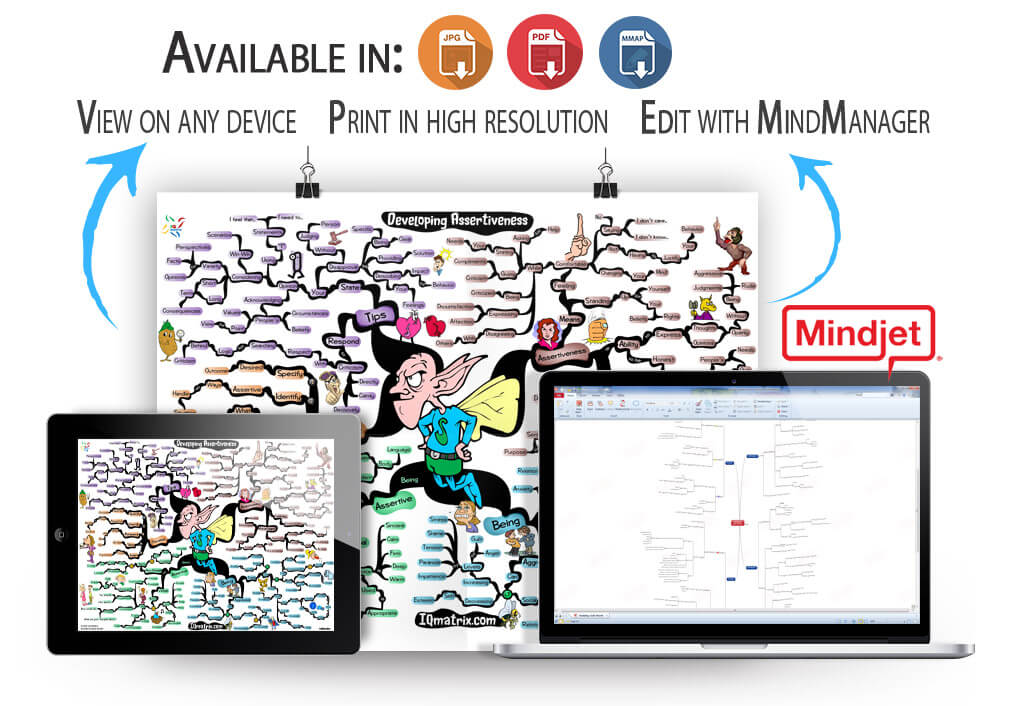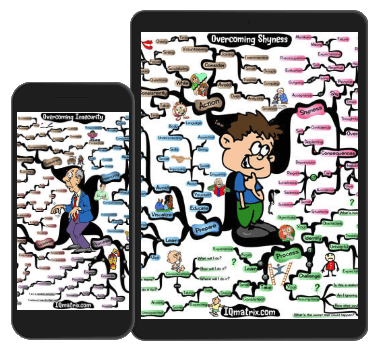The basic difference between being assertive and being aggressive is how our words and behavior affect the rights and well-being of others. – Sharon Anthony
What Does it Mean to be Assertive?
Assertiveness is the ability to express your thoughts and opinions openly without being rude, aggressive or judgmental. It’s about being honest while at the same time respecting people’s needs and opinions.
To be assertive means to stand up for yourself — to stand up for your rights and beliefs when others are being critical or when they speak up against you.
Assertiveness is about feeling comfortable being yourself in various situations. More specifically, it’s about feeling comfortable changing your mind — acknowledging that you don’t know, don’t care, or just don’t have the time. It’s about not feeling the need to justify your actions or behavior to anybody else.
To be assertive means having the courage to ask for help, to express your dissatisfaction or affection, to give compliments and constructive feedback, and to disagree with others with an open and honest perspective.
The Key Advantages of Developing Your Assertiveness
Assertiveness is a learned communication style that we can develop with practice. It’s something you can progressively learn that will improve your chances of getting what you want out of life.
Learning to become more assertive can also help enhance self-esteem and self-confidence. Furthermore, it tends to decrease feelings of anxiety typically experienced in social situations. With less anxiety and more self-confidence, you feel more self-assured which subsequently helps improve your personal and professional relationships.
Most importantly, assertiveness is something that can provide you with a sense of purpose and control over your life and circumstances. No longer will you fall prey to other people’s controlling nature. You will instead take your life and destiny into your own hands and move forward with a greater sense of confidence and purpose.
Assertiveness is the Middle Ground Between Being Timid and Aggressive
When you think about being assertive, it might bring to mind someone who is overly aggressive and rude. Possibly a power-monger who is determined and hungry to get their way irrespective of how it affects other people.
On the opposite side of the spectrum, you might be thinking that you just don’t have a brutish nature. You deeply respect other people’s needs, wants, and desires, and therefore, couldn’t imagine roughing up another person’s feathers. With this in mind, you tend to be a little more shy and timid in social situations. You instead give your power away rather than create conflict.
Being timid, of course, has some advantages. However, the disadvantages significantly outweigh the value you will gain from this type of approach.
When we’re timid, we tend to act out of fear. We don’t want to be seen as rude or selfish. We, therefore, hold ourselves back from expressing what we want in each situation. These fears, of course, stem from unrealistic beliefs, cultural influences or through a lack of social skills.
Possibly, we were never taught from a young age how to handle difficult social situations. Perhaps, we were taught that asking for what we want was rude, disrespectful, and inappropriate.
Given all this, it’s clear that expressing an opinion can lead to doubt and uncertainty. There’s always the chance that other people won’t agree with us. As a result, there is this lingering fear or criticism and rejection hanging over our heads. We, therefore, become very apologetic and overly vulnerable to other people’s opinions.
Living this way raises our anxiety and subsequently leads to higher levels stress. What’s worse, is that people begin to see us like doormats. Yes, we are agreeable and want to appease everyone. However, most people you meet will only use that to their advantage to further their own cause. They take advantage of us because there is a lack of respect in the relationship.
Given these consequences, you could, of course, decide to move yourself to the opposite side of the spectrum. Here you aggressively fight for what you want without a second thought about the consequences of your actions or the impact it has on other people.
Now, being overly aggressive will most likely get you what you want in the short-run. You certainly won’t be at the whim of other people. Nobody will ever push you into a corner. However, by being overly aggressive, you will quickly rub people the wrong way and make enemies in the long-run.
To live life in an overly aggressive manner often leads to a very stressful existence. Excessively aggressive individuals tend to be guilt-ridden, impatient, and angry. What’s more, is that they feel as though the entire world is against them. As a result, they tend to suffer from paranoia.
Overly aggressive people might seem as though they have all the confidence in the world, but under their exterior, they struggle with self-esteem issues. Moreover, they also struggle with shame that stems directly from their actions.
However, they know no other way to get what they want from life. And so they continue to rub people the wrong way and continuously burn bridges. This, of course, leads to dysfunctional relationships that hurt their social growth and development.
So, given these two polar opposites, where’s the middle ground? Well, that middle ground can be found when we use the power and strength of assertiveness.
Assertiveness is neither timid nor aggressive. It’s rather somewhere in between where you reach a perfect balance between respect and influence.
But, what does it truly mean to be assertive? And where’s the fine line between being assertive and aggressive?
The Verbal and Non-Verbal Cues for Assertive Behavior
There is a fine line between being assertive and aggressive. And that fine line comes through the verbal and non-verbal cues we use when we communicate with other people.
The Verbal Habits
When we’re assertive, our voice needs to be sincere, calm, firm, deep, and warm. We need to come across as being respectful of the other person’s needs, wants and desires. But at the same time, we also need to be confident in our demeanor and in the message that we are trying to get across.
An assertive person always uses a fluid and steady communication style. An aggressive person, on the other hand, uses a very sharp and unpredictable communication style.
An assertive person uses cooperative phrases to get his/her point across. For instance, they might say:
“How could we…?”
“What are your thoughts about (such and such)…?”.
They are very suggestive with their language and make statements that are clear, straightforward and brief.
On the other hand, an aggressive person doesn’t come across as being very cooperative or open-minded. Instead of making suggestions, they lay down their law. In other words, it’s their way or the highway. They are very forceful and direct with their language and will often use their credentials, status or authority to get their way.
While the assertive person provides constructive feedback and criticism, the aggressive person has absolutely nothing constructive to say. They instead use guilt and shame to manipulate people into doing what they want.
The Non-Verbal Habits
An assertive person often uses open and confident body language. They are deeply in-tune with how others perceive them. Given this, they make an effort to ensure that they come across as being friendly, non-threatening, and respectful.
An aggressive person, on the other hand, will use very authoritative and closed body language. This displays power, but, also confirms that they’re not in the slightest open to new perspectives or opinions.
An assertive person often shows respect by listening to people’s thoughts and ideas. This is, of course, evident through their eye-contact. They maintain steady yet gentle eye-contact with the person they are communicating with without coming across in an overbearing way.
The aggressive person will, of course, also give good eye contact in such situations. However, their eye-contact will often come across as being very piercing and judgmental. This gives the impression that they don’t care much about the other person’s opinion. Instead, they are only interested in getting their way.
A Five-Step Process for Being More Assertive in Social Situations
You should now have a good understanding of what it takes to be more assertive in your day-to-day interactions with other people. However, what’s missing is a process of steps we can use as a framework for developing the habit of assertiveness.
Here in this section, let’s walk through a quick five-step process you can use to help you develop the habit of assertiveness so you can begin feeling more confident in social situations.
Step 1: Specify Your Desired Outcome
Take a moment to think about a social situation where you would like to be a little more assertive. Typically this will be a situation where you’ve previously struggled to assert yourself.
Now, consider how you would like to be and what you would want to gain from this situation. Ask yourself:
How would I like to be in this social situation?
What exactly would I like to gain from this social situation?
What would I like to be able to do?
What is my desired outcome?
Answering these questions will help you outline your goal. You will now use this goal as a target to help you figure out what you need to do to become more assertive in that particular situation.
Step 2: Identify Assertive Ways to Handle the Situation
Reflecting on your goal and on the type of person you would like to be in that particular situation, consider several assertive ways you could handle things. Ask yourself:
How have I handled this situation in the past? What was the outcome?
How would I like to handle this situation from now on?
How will I need to act? What will I need to do? How do I need to respond to handle this in an assertive way?
How will handling the situation in this way be of value?
Will handling the situation in this way help me achieve my desired outcome?
What if things don’t pan out as I expect they will?
What potential obstacles or setbacks could arise?
How will I deal with these setbacks? How will I adapt my approach to stay on track?
What contingency plans must I set in place for when things don’t go to plan?
It’s essential that you’re very clear about how you will handle things. The more clarity you have about this, the more confidence you will have moving forward.
Step 3: Rehearse What You Will Do and Say
You should by now have excellent clarity about what it is you want, and about what it will take to be assertive in your chosen scenario. However, just knowing what you want and understanding how you will go about things, unfortunately, isn’t enough.
Many people have a clear idea about how to be more assertive in certain situations, but when it comes time for their performance, they, unfortunately, shy away from the spotlight.
A stage actor spends hours-upon-hours practicing their lines before their big performance. And maybe, this is a significant reason why they ooze with confidence when they finally get on stage to perform.
The time they spent practicing has given them the self-confidence they need to perform at a high level. And, of course, the same applies in your situation.
Just like the stage actor, you too need to practice your lines before your big performance.
With this in mind, first, take the time to practice being assertive in front of a mirror.
Next, garner the help of a close friend and practice role-playing the scenario you had in mind. You can also practice imagining yourself playing out the scene in your imagination.
The more practice you get, the more confident you will feel when you take the stage.
Step 4: Take Action
It’s now time to take action. Be sure to stay calm and collected. Expect the unexpected and be ready to adapt your approach when things don’t entirely go to plan.
No matter what happens, know your goal and focus on bringing about your desired outcome.
Step 5: Learn From Your Experience
The final step of this process is probably the most crucial step. This is where you learn from your experience and use those lessons to improve your efforts the next time around.
To help you with this task, ask yourself:
How did things pan out?
What did I do well that worked out in my favor?
Where did I mess up that worked against me?
What key lessons has this experience taught me?
Where exactly could I improve to do better the next time around?
No matter what happens, remember, that there is no failure. There is only feedback. What’s important is how you use that feedback to help you do better the next time around.
Practicing Your Assertiveness Skills
Here in this final section, let’s explore three key scenarios that will help you practice being more assertive.
How to Respond to Criticism
Here within this first scenario you are being criticized or judged by another person. Handling criticism, of course, isn’t easy, which is why many people typically struggle with criticism.
People tend to handle criticism in one of two ways. They either get defensive and angry or they get very self-conscious and start feeling insecure. Which one are you?
There is, of course, a more optimal way to handle criticism, which is to respond to it in a direct, calm, and decisive manner.
The assertive person understands that criticism is merely a part of life. People will not always share your feelings, perspectives or opinions. In fact, some of them will even take the initiative to verbalize their disapproval.
During such times, the assertive person stays calm and open-minded. They show respect for the other person and search for the logic behind their argument.
Getting emotionally riled up about the criticism will rarely ever work in your favor. This is why trying to make logical sense of the criticism is of value.
When we logically process the other person’s critical words, we can then respond to their criticism assertively and confidently.
If their criticism makes no logical sense, then let them know. But of course, if there is some truth to their words, then own up to your errors and take action to correct your mistakes.
In the end, criticism can only help you improve. At the very least it will make you aware of other points-of-view that you might not have considered.
How to State Your Opinion
Here in this second scenario, your objective is to express an opposing opinion that goes against what others deem to be true or acceptable. To do this assertively requires a little thought and consideration.
Firstly, it’s crucial that you keep an open mind and acknowledge people’s beliefs, values, and opinions. Everyone is unique and has their own life experiences and perspectives. There are also, of course, facts that could potentially contradict your personal views.
Before giving your opinion, take into consideration the short and long-term consequences of your words.
Possibly, what you’re about to say may negatively affect other people. Just maybe, stating your opinion in this situation might not be worth the consequences.
Your ideal objective is to make your point in an assertive way that doesn’t burn bridges. In other words, ensure that it doesn’t hurt your relationship with other people. Given this, you must be respectful. Don’t use your opinion as a platform to undermine other people’s views. Use it instead to only make a point.
When making your point, use “I” statements to signal to the other person that it’s your opinion and not fact (e.g., “I feel that…”). You are stating your own opinion and putting forward your personal perspective on the situation. In this way, you are not overly aggressive, but rather somewhat suggestive.
To be more persuasive in this scenario, be sure to acknowledge the other person’s perspective and opinion. Get them on your side first by showing them that you understand where they’re coming from. Only then should you share your own view and ideas. In this way, they will be more open to your point-of-view.
How to Give Your Disapproval
The final scenario is a little more complicated, as it requires you to be critical and disapprove of someone’s behavior.
In such a scenario, it’s easy for us to use our status or authority to get our way. However, when you’re assertive, you don’t necessarily need to use that approach.
When disapproving of someone, it’s essential to do so without judgment. By all means, be assertive and share your disapproval. However, don’t disapprove of the person, but rather disapprove of their behavior in that particular situation.
It’s also important that you’re very clear and accurate about what exactly you disapprove. Ideally, you will want to mention the impact of this behavior and how it makes you feel. However, don’t just make this about you. Make it instead about the other person — about your concern for them.
It’s, of course, all well and good to disapprove and then to leave things as they are. Ideally, though, you will want to provide a solution that can help the other person work through their behavior in an optimal way.
The key to convincing the other person of your position and argument comes through your level of assertiveness. If you’re assertive enough (without being aggressive), the other person will more likely take your suggestions to heart. If you, however, tackle this aggressively, then the likelihood is that nothing will get resolved.
On the other hand, if you timidly approach this scenario, then you just won’t earn the person’s respect, and subsequently, no satisfactory resolution will come about. The key then is to find the middle-ground. That is where being assertive has the most value.
Concluding Thoughts
Developing assertiveness is part of social growth and development. It’s a social skill you can use to win friends and influence more people. And it could very well be one of the most important skills you will ever learn. It could just help you get what you want a lot faster.
But learning to be assertive, of course, takes work. It’s not something that we can immediately master overnight. It’s instead something that will take time and practice. In fact, you will likely make plenty of mistakes along the way. You may even cross-the-line several times and come across as being either a little too aggressive or too timid in various situations. Simply learn from these experiences and work on adapting your approach when facing similar future scenarios.
Time to Assimilate these Concepts
Did you gain value from this article? Is it important that you know and understand this topic? Would you like to optimize how you think about this topic? Would you like a method for applying these ideas to your life?
If you answered yes to any of these questions, then I’m confident you will gain tremendous value from using the accompanying IQ Matrix for coaching or self-coaching purposes. This mind map provides you with a quick visual overview of the article you just read. The branches, interlinking ideas, and images model how the brain thinks and processes information. It’s kind of like implanting a thought into your brain – an upgrade of sorts that optimizes how you think about these concepts and ideas. 🙂
Recommended IQ Matrix Bundles
If you’re intrigued by the idea of using mind maps for self-improvement then I would like to invite you to become an IQ Matrix Member.
If you’re new to mind mapping or just want to check things out, then register for the Free 12 Month Membership Program. There you will gain access to over 90 mind maps, visual tools, and resources valued at over $500.
If, on the other hand, you want access to an ever-growing library of 100s of visual tools and resources, then check out our Premium Membership Packages. These packages provide you with the ultimate visual reference library for all your personal development needs.
Gain More Knowledge…
Here are some additional links and resources that will help you learn more about this topic:
- 3 Ways to be More Assertive at Work Without Being a Jerk @ Psych Central
- 5 Tips to Increase Your Assertiveness @ Psych Central
- 5 Ways to be More Assertive in Your Everyday Life @ Bustle
- 6 Tips for Being More Assertive at Work @ Good Therapy
- 7 Powerful Habits that Make You More Assertive @ Inc.
- Assert Yourself by Working with People, Not Against Them @ Mind Tools
- Building Assertiveness in Four Steps @ Psych Central
- How to be Assertive, Not Aggressive @ Psychology Today
- How to be Assertive Without Losing Yourself @ Harvard Business Review
- How to be More Assertive at Work with 7 Simple Tips @ Bustle
- The 6 Secrets of Successful Assertive Leaders @ Forbes
- The Weird Way My Anxiety Led Me to Being More Assertive @ Elite Daily

